

Wiki: Man-Eating Animals. Andrée's Arctic balloon expedition. Failed attempt to reach the North Pole by balloon Andrée's Arctic balloon expedition of 1897 was an effort to reach the North Pole in which all three Swedish expedition members – S.

A. Andrée, Knut Frænkel, and Nils Strindberg – perished. Batavia (1628 ship) 1628 flagship of the Dutch East India Company Batavia ([baːˈtaːviaː] ( listen)) was a ship of the Dutch East India Company.
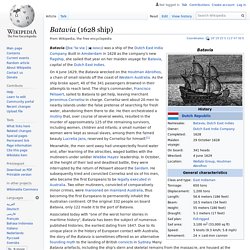
Built in Amsterdam in 1628 as the company's new flagship, she sailed that year on her maiden voyage for Batavia, capital of the Dutch East Indies. Great Molasses Flood. The Great Molasses Flood, also known as the Boston Molasses Disaster or the Great Boston Molassacre, occurred on January 15, 1919, in the North End neighborhood of Boston, Massachusetts, in the United States.

A large molasses storage tank burst, and a wave of molasses rushed through the streets at an estimated 35 mph (56 km/h), killing 21 and injuring 150. The event has entered local folklore, and for decades afterward residents claimed that on hot summer days the area still smelled of molasses.[1] Flood[edit] Dyatlov Pass incident. The Dyatlov Pass incident (Russian: Гибель тургруппы Дятлова) refers to the unsolved deaths of nine ski hikers in the northern Ural Mountains in the Soviet Union (now Russia) between 1 February and 2 February 1959.

The area in which the incident took place was named Dyatlov Pass in honor of the group's leader, Igor Dyatlov. The experienced trekking group, who were all from the Ural Polytechnical Institute, had established a camp on the slopes of Kholat Syakhl when disaster struck. During the night, something caused them to tear their way out of their tents and to flee the campsite while inadequately dressed during a heavy snowfall and sub-zero temperature. After the discovery of the group's bodies, Soviet Union investigators determined that six victims died from hypothermia and that the three others showed signs of physical trauma. One victim had a fractured skull; another had brain damage but no sign of an injured skull.
2016 clown sightings. Rash of random appearances of malevolent clowns The 2016 clown sightings were reports of people disguised as evil clowns in incongruous settings, such as near forests and schools.
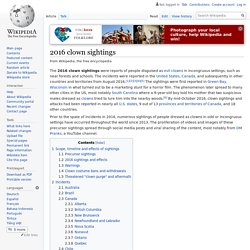
The incidents were reported in the United States, Canada, and subsequently in other countries and territories from August 2016.[1][2][3][4][5] The sightings were first reported in Green Bay, Wisconsin in what turned out to be a marketing stunt for a horror film. The phenomenon later spread to many other cities in the US, most notably South Carolina where a 9-year-old boy told his mother that two suspicious males dressed as clowns tried to lure him into the nearby woods.[6] By mid-October 2016, clown sightings and attacks had been reported in nearly all U.S. states, 9 out of 13 provinces and territories of Canada, and 18 other countries.
John F. Kennedy autopsy. The autopsy of President John F.

Kennedy was performed, beginning at about 8 p.m. Disappearance of Bobby Dunbar. The child raised as Bobby Dunbar standing in front of a car.
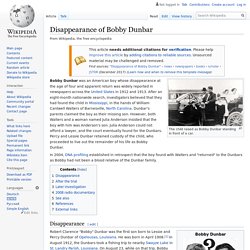
Bobby Dunbar was an American boy whose disappearance at the age of four and apparent return was widely reported in newspapers across the United States in 1912 and 1913. After an eight-month nationwide search, investigators believed that they had found the child in Mississippi, in the hands of William Cantwell Walters of Barnesville, North Carolina.
Dunbar's parents claimed the boy as their missing son. However, both Walters and a woman named Julia Anderson insisted that the boy with him was Anderson's son. Julia Anderson could not afford a lawyer, and the court eventually found for the Dunbars. Year Without a Summer. The year 1816 is known as the Year Without a Summer (also known as the Poverty Year, The Summer that Never Was, Year There Was No Summer, and Eighteen Hundred and Froze to Death[1]), because of severe summer climate abnormalities that caused average global temperatures to decrease by 0.4–0.7 °C (0.7–1.3 °F),.[2] This resulted in major food shortages across the Northern Hemisphere.[3][4] Evidence suggests that the anomaly was caused by a combination of a historic low in solar activity with a volcanic winter event, the latter caused by a succession of major volcanic eruptions capped by the 1815 eruption of Mount Tambora, in the Dutch East Indies (Indonesia), the largest known eruption in over 1,300 years.
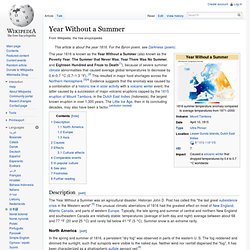
The Little Ice Age, then in its concluding decades, may also have been a factor. [attribution needed] Description[edit] The Year Without a Summer was an agricultural disaster. Historian John D. North America[edit] Many commented on the phenomenon. Europe[edit] Asia[edit] Causes[edit] List of largest empires. An empire involves the extension of a state's sovereignty over external territories and variety of different ethnic groups.
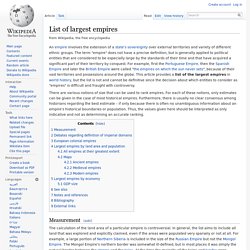
The term "empire" does not have a precise definition, but is generally applied to political entities that are considered to be especially large by the standards of their time and that have acquired a significant part of their territory by conquest. Mary Celeste. Mary Celeste was built in Spencer's Island, Nova Scotia, and launched under British registration as Amazon, in 1861.
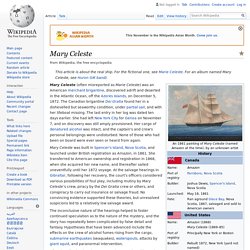
She transferred to American ownership and registration in 1868, when she acquired her new name, and thereafter sailed uneventfully until her 1872 voyage. At the salvage hearings in Gibraltar, following her recovery, the court's officers considered various possibilities of foul play, including mutiny by Mary Celeste's crew, piracy by the Dei Gratia crew or others, and conspiracy to carry out insurance or salvage fraud. No convincing evidence supported these theories, but unresolved suspicions led to a relatively low salvage award. The inconclusive nature of the hearings helped to foster continued speculation as to the nature of the mystery, and the story has repeatedly been complicated by false detail and fantasy.
After the Gibraltar hearings, Mary Celeste continued in service under new owners. Early history[edit] Wreckage of the Essex. Essex was an American whaler from Nantucket, Massachusetts, which was launched in 1799. In 1820, while at sea in the southern Pacific Ocean under the command of Captain George Pollard Jr., she was attacked and sunk by a sperm whale. Stranded thousands of miles from the coast of South America with little food and water, the 20-man crew was forced to make for land in the ship's surviving whaleboats. Great Fire of London. Detail of the Great Fire of London by an unknown painter, depicting the fire as it would have appeared on the evening of Tuesday, 4 September 1666 from a boat in the vicinity of Tower Wharf. The Tower of London is on the right and London Bridge on the left, with St. Paul's Cathedral in the distance, surrounded by the tallest flames.
The Great Fire of London was a major conflagration that swept through the central parts of the English city of London, from Sunday, 2 September to Wednesday, 5 September 1666.[1] The fire gutted the medieval City of London inside the old Roman city wall. It threatened, but did not reach, the aristocratic district of Westminster, Charles II's Palace of Whitehall, and most of the suburban slums.[2] It consumed 13,200 houses, 87 parish churches, St. List of unusual deaths. This is a list of unusual deaths. This list includes unique or extremely rare circumstances of death recorded throughout history, noted as being unusual by multiple sources. Some of the deaths are mythological or are considered to be unsubstantiated by contemporary researchers. Oxford Dictionaries defines the word "unusual" as "not habitually or commonly occurring or done" and "remarkable or interesting because different from or better than others.
Lisztomania. Lisztomania or Liszt fever was the intense fan frenzy directed toward Hungarian composer Franz Liszt during his performances. This frenzy first occurred in Berlin in 1841 and the term was later coined by Heinrich Heine in a feuilleton he wrote on April 25, 1844, discussing the 1844 Parisian concert season. Lisztomania was characterized by intense levels of hysteria demonstrated by fans, akin to the treatment of celebrity musicians today – but in a time not known for such musical hysterics. Background[edit] Stanford prison experiment. The Stanford prison experiment (SPE) was a study of the psychological effects of becoming a prisoner or prison guard. The experiment was conducted at Stanford University from August 14–20, 1971, by a team of researchers led by psychology professor Philip Zimbardo.[1] It was funded by the US Office of Naval Research[2] and was of interest to both the US Navy and Marine Corps as an investigation into the causes of conflict between military guards and prisoners.
Goals and methods[edit] Zimbardo and his team aimed to test the hypothesis that the inherent personality traits of prisoners and guards are the chief cause of abusive behavior in prison. Participants were recruited and told they would participate in a two-week prison simulation. Poisoning of Alexander Litvinenko. In the UK, Litvinenko became a journalist for a Chechen separatist site, Chechenpress. Litvinenko wrote two books, Blowing up Russia: Terror from within and Lubyanka Criminal Group, where he accused the Russian secret services of staging Russian apartment bombings and other terrorism acts to bring Vladimir Putin to power.
On 1 November 2006, Litvinenko suddenly fell ill and was hospitalized. He died three weeks later, becoming the first confirmed victim of lethal polonium-210-induced acute radiation syndrome.[2] According to doctors, "Litvinenko's murder represents an ominous landmark: the beginning of an era of nuclear terrorism".[3][4][5] Litvinenko's allegations about the misdeeds of the FSB and his public deathbed accusations that Russian president Vladimir Putin were behind his unusual malady resulted in worldwide media coverage.[6] Background[edit source | editbeta] Illness and poisoning[edit source | editbeta] Poison[edit source | editbeta] In his last statement he said about Putin: Donner Party. A group of American pioneers who were trapped in the Sierra Nevada, forcing them to resort to cannibalism.
The 28th page of Patrick Breen's diary, recording his observations in late February 1847, including "Mrs Murphy said here yesterday that thought she would Commence on Milt & eat him. I dont that she has done so yet, it is distressing. " Black Death. Mutiny on the Bounty. Microsoft vs. MikeRoweSoft. Dominican Republic–Haiti relations. Flannan Isles Lighthouse. MV Joyita.